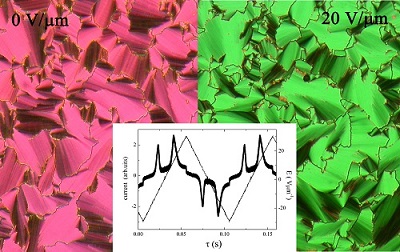
Liquid crystals
The group concentrates on new applications of liquid crystals within the framework of information and communication technologies. Self-assembling properties of liquid crystalline molecules and their unique electro-optical properties have been known for many years and have been applied for example in displays, monitors, and different measuring or detecting devices. Recently smectic liquid crystals with dipolar ordering have dominated in liquid crystalline research. Their unrivalled physical properties opened new perspectives for applications in data processing and in operating or measuring systems that on the contrary stimulated interest in synthesis and studies of such materials. Other still open questions concern relationship among polarity, chirality and symmetry. Effects of ferro- and antiferroelectricity generally need symmetry breaking, which can be caused for example by chirality of molecules. Nevertheless, there are smectic phases formed by molecules with bent-core shape, in which the miror symmetry breaking resulted from closed packing of molecules. Additionally, depending on its shape molecules can create columnar phases, which can be useful in photovoltaics or molecular electronics.

Figure:
Electrooptical response and polarization current in antiferroelekctric
liquid crystalline materials.
In the last years, we have synthesized a large amount of liquid crystalline compounds revealing variability of mesomorphic behaviour. The main task is the preparation of new ferro- and antiferroelectric materials with targeted physical properties, design of new liquid crystalline compounds with various shapes (from rod-like, to hockey-stick and bent-core) and chirality aspect, with new functionality (fotosensitivity, paramagnetic radicals, luminescent core etc.). Our aim is better understanding the relationship between molecular structure and mesomorphic properties, between polarity and chirality of these systems, better understanding of the phase transition mechanisms.
We concentrate on photosensitive liquid crystalline compounds, in which the illumination of light with specific wavelength can induce change of the molecular shape and molecular ordering in mesophase. The effect of photoisomerization is well-know, but its utilization for optical switching, data recording and data storage have not been deeply studied yet. Often the azo-derivatives are exploited for treatment providing anchoring of molecules at cell surface. In future we will devote to new types of organic compounds with more complicated molecular shape and more complex photoizomerization proces. We will prepare spiropyran derivatives, characterize them a study the photoizomerization in such systems.
Recently the liquid crystalline compounds based on organic molecules with different shapes are combined with inorganic nanoparticles bringing about other functionalities. Development and production of nanoparticles with different physical properties (optical, magnetic, electric or dielectric) have problems with their arrangement. Liquid crystals seem to be ideal candidates for preparation of new hybrid systems combining functionalities of nanoparticles with self-organization and mobility on molecular level. New types of hybrid systems with nanoparticles will be based not only on liquid crystalline compounds, but also polymers, elastomers, gels, cellulose-based organic compounds will be used. Interaction between nanoparticles and liquid crystalline molecules strongly depends on combination of different factors, like character, dimension and shape of nanoparticles and molecular structure and elasticity. We will optimize the composition of studied hybrid systems with respect to obtained preliminary results.
This research activity of the group is interdisciplinary and includes organic and inorganic chemistry, technology and different fields in physics (ferroelectricity and magnetism, optics and electro-optics), touching a borderline of biology and medicine (development of different sensors, smart textiles etc.).

